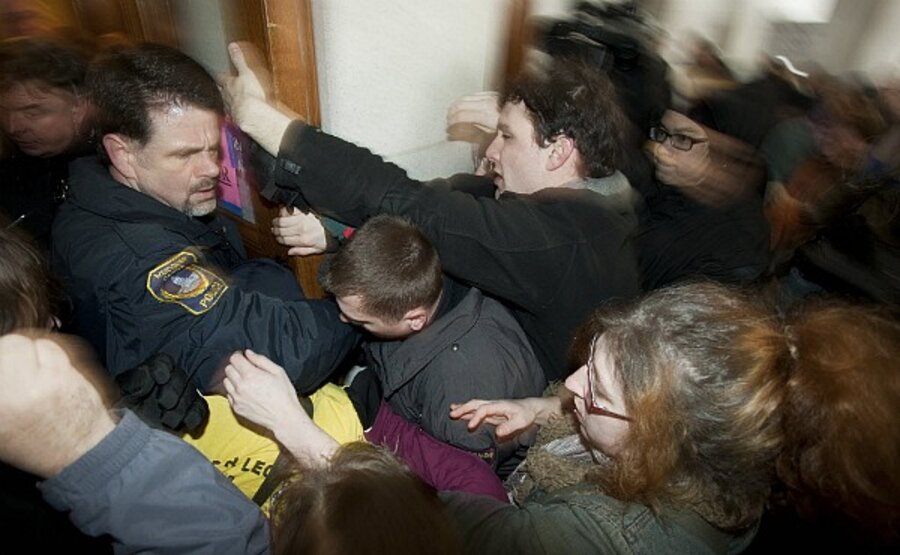Wisconsin protests: 'democracy in action' or 'mob rule'?
Loading...
As Republican lawmakers in Wisconsin moved this week to gut collective bargaining for most of the state’s employees, cameras caught protesters storming the Capitol – breaking doors and windows – in a last-ditch push to protest and possibly block the vote.
They were scenes that, in some respects, warmed the hearts of American labor: unions, for so long moribund and grappling with a loss of clout, infused with new energy and purpose. From the ashes of Wisconsin came the rebirth of union power and a powerful portrait of democracy in action, some proclaimed.
Yet others slightly less impressed by the spectacle are now offering a different interpretation: the masses came dangerously close to trampling the United States Constitution underfoot.
IN PICTURES: Wisconsin Capitol protests
The argument is an arcane one, even by the measure of constitutional law. But it centers on a clause in Article 4, which orders the federal government to guarantee representative government in the states instead of a direct democracy, and says the federal government shall protect the states against domestic violence.
By one historical reading, this gave the federal government a stick to beat down rabble-rousers trying to take over state government. In other words, the clause was intended to push back against forms of democratic politics that emerged in the late 18th century, when ordinary citizens took over legislatures – overriding elected representatives – and passed the laws they liked, such as debt relief bills and the institution of paper money.
But that's not the only interpretation of the so-called "guarantee clause." Some say it was actually meant to do virtually the opposite – preventing states from sliding toward rule by aristocrats.
For those inclined to see the clause as a protection against representative, republican government, however, this week in Wisconsin looked like a case study in lawmakers being threatened by the law of the street.
On Thursday, Sen. Ron Johnson (R) of Wisconsin denounced what he saw as "mob rule" trying to thwart the electoral will of the people, citing specficially the "amount of thuggery, the threats of execution" against Republican lawmakers.
University of Wisconsin law professor Ann Althouse viewed the events in the Capitol as a near-total breakdown of law and order. "How do you like this new democracy, that has a mob storming the Capitol and, with the aid of the minority party, blocking the access of the majority party into their offices and into the legislative chamber?" Professor Althouse wrote on her blog. "It looks more like anarchy to me."
To others, this was precisely the sort of situation for which the guarantee clause was created.
"It is hard to recall many moments that more directly echo the concerns of the founders than the situation America faces today, with a mob of protesters, some bused in from out of state by labor unions bent on protecting their financial interests, occupying the state house at Madison and the governor there under heavy guard," states a New York Sun editorial.
The protests were peaceful, on the whole – with only 18 arrests during more than three weeks of steady protests in Madison – but critics question whether Dane County Sheriff Dave Mahoney, too, was taking sides.
"We are seeing democracy in action, people engaging in their government, making their issues known," Sheriff Mahoney told Time magazine. " I'm very proud that the people of Wisconsin are engaged in their government and shown the rest of the world how democracy works."
At one point, he said his deputies "aren't palace guards."
Neither should they be urging on the crowds, though, said Cornell University law professor William Jacobson. The appearance of a bullhorn-toting protester on Feb. 27 in a "COPS FOR LABOR" T-shirt showed that "the police union members involved have actively advocated and offered to participate in insurrection against the legal authority in Wisconsin," writes Mr. Jacobson on his blog, Legal Insurrection.
Yet such observations connect the dots incorrectly, argues says Barry Burden, a political scientist at the University of Wisconsin. "I don't think any of the Republican leadership has accused law enforcement of siding with protesters or abetting them in anyway, which, by the way, would be a terrible political move for them, accusing people of being traitors."
Likewise, other observers suggest that critics of the protests are misinterpreting the guarantee clause. In practice, Congress has used it only a few times, notably by Radical Republicans to push through the 13th and 14th amendments – to abolish slavery and keep former Confederates from holding office without congressional approval – despite opposition from unreconstructed Southern lawmakers during Reconstruction.
In that light, "the truth about the guarantee clause is that its initial purpose was less a concern with popular protest and far more a worry with potential backsliding by state governments into aristrocratic or monarchical forms of government," says Cornell University law professor Aziz Rana, author of "The Two Faces of American Freedom."
"That would suggest to me that ... peaceful protest combined with local police sympathy and the decision by some legislators to flee to Illinois are not issues that would invoke the guarantee clause," he adds.
To the contrary, he says, the precedent for such protests is long and well established in American history. "The labor movement struggled for decades to defend collective bargaining and the right to strike through popular protests," and by that measure, Professor Rana says, it is curious that the protests "were presented by those in power as mobs that justified calling in federal troops or imposing draconian policies."
Editor's note: Monitor staff photographer Ann Hermes traveled with Wisconsin farmers on March 12 in a 'tractorcade' to the Wisconsin state capital in Madison to protest Gov. Scott Walker's efforts to stifle collective bargaining.
IN PICTURES: Wisconsin Capitol protests





